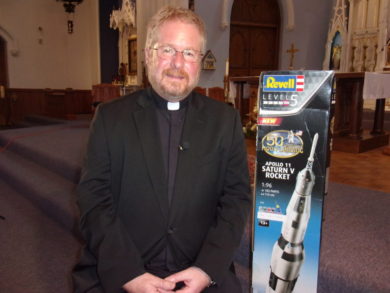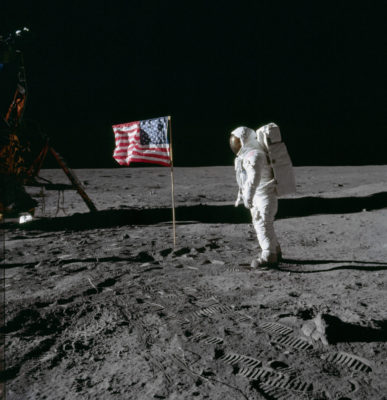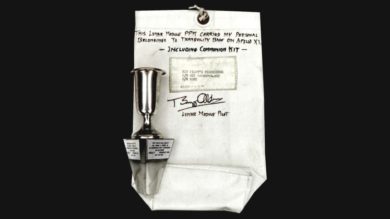July 28, 2019
Astronomer priest remembers moon landing on 50th anniversary
REGIONAL
By Stephen Kiltonic

(Catholic Communications file photo/Fred LeBlanc)
EASTHAMPTON – On July 16, 1969, the massive 30-story, 6 million pound Saturn V rocket lifted off from Cape Canaveral, Fla., with American astronauts Neil Armstrong, Edwin “Buzz” Aldrin and Michael Collins on board.
After a 238,900 mile, four-day journey, the Apollo 11 crew reached their destination – the moon. On July 20, 1969, Commander Neil Armstrong made history when he stepped out of the Eagle landing module in the Sea of Tranquility becoming the first human to step onto the lunar surface uttering, “One small step for man, one giant leap for mankind.”
Aldrin soon joined him as Collins piloted the Columbia command module in an orbit around the moon. After nearly a day on the surface, the module docked with the mother ship and four days later, the Apollo 11 crew splashed down safely in the Pacific.
This year marks the 50th anniversary of that lunar landing.
An estimated 600 million people – one-fifth the world’s population at the time – watched and listened to the first moon landing including then 10-year-old Douglas McGonagle of Billerica, Mass. He would later earn a bachelor’s and doctoral degree in astronomy from the University of Massachusetts Amherst and be ordained Father Douglas McGonagle, now the pastor of Our Lady of the Valley Parish in Easthampton.
Father McGonagle has always had an interest in space and space exploration going back as far as he could remember. He was born in 1959, right after Sputnik was sent up by the Russians. It was the height of the U.S.-Soviet space race.
“It was a period of time when your Cheerios box had pictures of astronauts and Chuck Yeager and science and space and rockets and airplanes and electronics was what you ate and breathed all the time,” said Father McGonagle.

Father Douglas McGonagle poses with the Revell Apollo V Saturn V rocket he built when he was 10 years old. (IObserve photo/Stephen Kiltonic)
His father worked in the high-tech industry making optics for several of NASA’s space programs, including Apollo. Engineers and space were just a natural part of his growing up. And when President John F. Kennedy proclaimed, in 1962, that America should commit itself to landing a man on the moon and return him safely to earth by the end of the decade, Americans were ready for the challenge.
“We choose to go to the moon in this decade and do the other things, not because they are easy, but because they are hard,” said President Kennedy.
On that historic day 50 years ago, Father McGonagle was glued to a GE-portable TV set with his family — the kind that got only 12 channels.
“I remember my brothers and I were sitting on the living room floor watching this black-and-white TV and these fuzzy images, trying to figure out what exactly you’re looking at,” said Father McGonagle. “The actual TV transmissions were pretty blown out. The contrast was awful.”
Father McGonagle said, like everybody, he was “absolutely fascinated.” But he also knew the mission involved great risk. The Apollo program began in tragedy on Jan. 27, 1967 when three astronauts, Edward White, Virgil “Gus” Grissom and Roger Chaffee, were killed when a fire broke out in the Apollo 1 Command Module during a preflight test at Cape Canaveral.
“We knew that the smallest, little thing could be a death sentence for these people. So, I think I remember more about how brave these guys had to be,” said Father McGonagle.
The lunar landing was not without its religious connections. Buzz Aldrin, a Presbyterian minister, received permission to bring bread and wine with him on the mission and gave himself communion in preparation for his moon walk.

Astronaut Edwin “Buzz” Aldrin, lunar module pilot of the first lunar landing mission, poses for a photograph beside the deployed U.S. flag during an Apollo 11 extra-vehicular activity on the lunar surface July 20, 1969. (CNS photo/courtesy NASA)
Then Pope Paul VI was known as an admirer of space travel. At the Vatican observatory in Castel Gandolfo, Italy, the pontiff watched the landing as it occurred through the Schmidt telescope. He was one of the 57 world leaders who penned messages for the astronauts to leave on the moon for posterity writing, “For the glory of the name of God, who gives men such power, we pray and wish well for this wondrous endeavor.”
Three months later, the astronauts and their wives were invited to the Vatican where they received gifts from Pope Paul VI symbolic of the Magi, noting that the Wise Men were also guided by the stars. The pope prayed that people would continue to learn more about creation and see more clearly God’s infinite power, infinity and perfection.
The lunar landing remains one of humankind’s greatest achievements and has served as the inspiration for decades of scientific successes.
“I think it’s a moment in time that may never ever happen again,” said Father McGonagle, who cited the JFK assassination and 9/11 as comparable moments in history that almost everyone remembers.
“But, those events happened unexpectedly. They were traumatic, mesmerizing, life-changing. But here, the moon landing, everybody knew when it was going to happen and we were just at that stage in technological development where mass communication, planet-wide, was at that point where just about anybody who wanted to could see what was happening. So, there was an appointment and the whole planet paused for those few moments as they stepped out on the moon,” said Father McGonagle.
There would be five more successful moon landing missions up until 1972. The 50th anniversary has revived interest in America’s returning to the moon one day as possibly part of a mission to Mars. However, times are different now and while Father McGonagle believes that, as a race, we are going back to the moon and eventually on to Mars, what country gets there or who is behind the heavenly endeavor is anyone’s guess.
He said China, India and Israel all have expressed a desire to send astronauts to the moon and beyond along with independents like Amazon’s Jeff Bezos and Elon Muss, owner of SpaceX, who possesses the most powerful rocket in the world, the Falcon Heavy. “They’re pushing technology faster than any government can do because they can take risks, it’s their money,” said Father McGonagle.

Buzz Aldrin, a Presbyterian minister, received permission to bring bread and wine with him on the mission and gave himself communion in preparation for his moon walk.
Regardless, when others talk about the space program and manned space flight as being too costly and labor intensive (the Apollo program from 1960 until 1972 cost about $24 billion dollars (close to $100 billion in today’s dollars), Father McGonagle disagrees.
“There’s no choice for the human being not to explore, not to ask questions. It’s the same way as saying, ‘What use is a symphony?’A symphony doesn’t have to justify itself. Neither does man’s need for exploration.”
A video version of this story will be on an upcoming edition of “Real to Reel” which airs Saturday evenings at 7 p.m. on WWLP-TV22 NEWS and in the Berkshires Sunday mornings at 5:30 on Albany’s Fox 23, WXXA.


 Facebook
Facebook Youtube
Youtube
